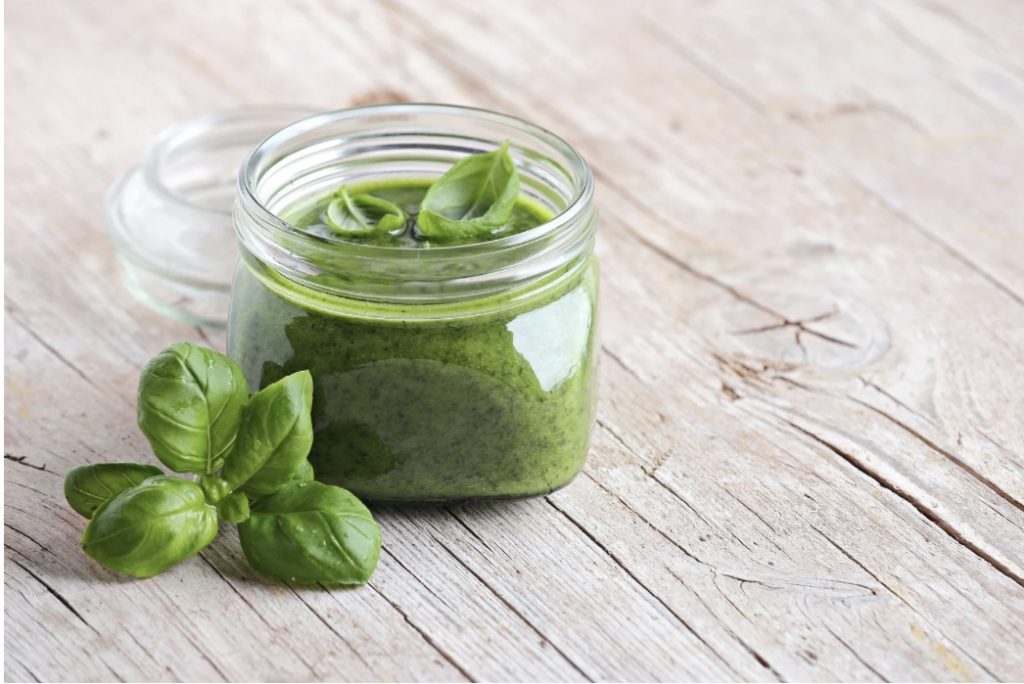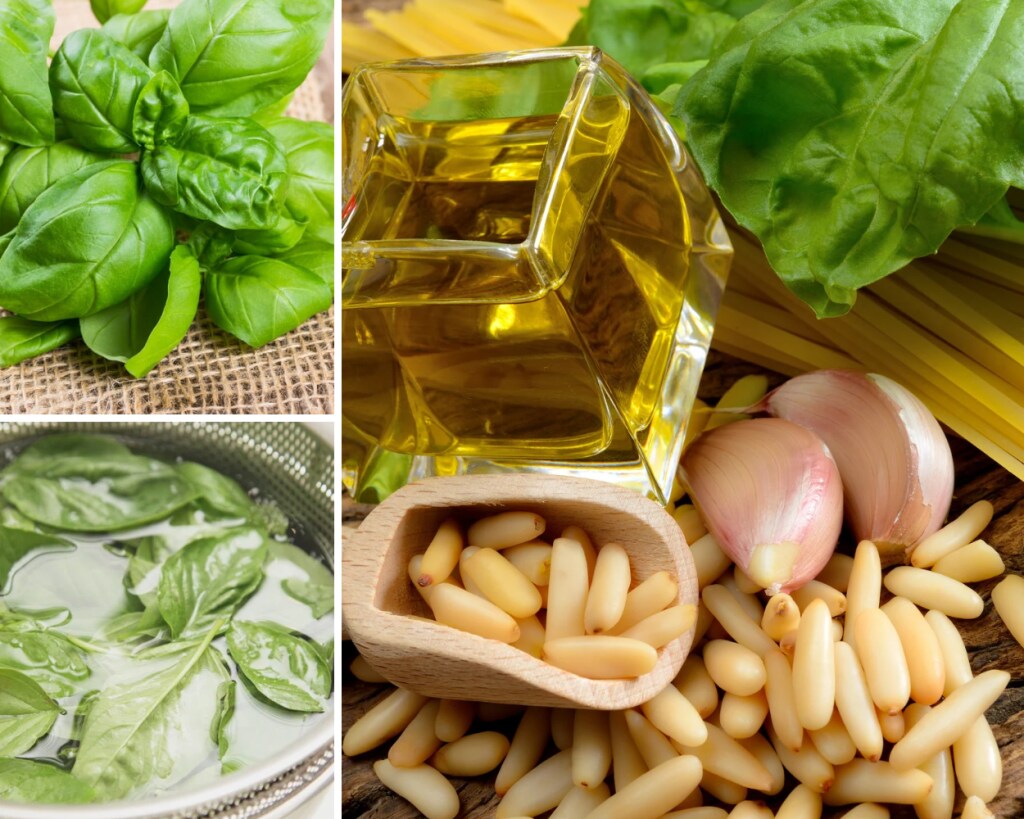Traditional Genovese Pesto: The Green Gold that Smells of Liguria!
A Journey into the History and Heart of Liguria
Dear food lovers, today I take you on a sensory journey into the wonderful Liguria, to discover an icon of our cuisine: Genovese Pesto! This dressing with a bright green color and intoxicating aroma is much more than just a pasta sauce: it is a concentrate of history, tradition, and passion for simple and authentic ingredients. Imagine the sun-kissed Ligurian hills, the crisp sea breeze caressing the fragrant leaves of Genovese DOP basil, the intense aroma of Vessalico garlic, the crunchiness of pine nuts, the savory taste of Parmigiano Reggiano and Pecorino Sardo, all enveloped by the fruity sweetness of Ligurian DOP extra virgin olive oil.
Every spoonful of pesto is a taste of this generous land, an explosion of flavors that tells centuries of culinary history. Its origins are rooted in ancient preparations based on aromatic herbs, evolving over time to become the gastronomic symbol we all know and love.
From Ancient Herbs to the King of Condiments
The roots of Genovese pesto can be traced back to ancient sauces, such as agliata, a garlic-based sauce already widespread in Roman times. During the Middle Ages, traces of similar sauces can be found, made with aromatic herbs, cheese, and dried fruit. However, the recipe that most closely resembles modern pesto appears in the 19th century, when Genovese basil began to be cultivated more extensively and became the main ingredient. The first written codification of “Genovese pesto” as we know it today dates back to 1863, in the book “La Cuciniera Genovese” by Giovanni Battista Ratto.
Since then, the recipe has been passed down from generation to generation, with small family variations, but always maintaining the essence of its basic ingredients and the strictly “cold” preparation to best preserve the fresh aromas of basil. Pesto is not just a condiment, but a true emblem of Liguria, a treasure to be preserved and valued.
Here are other recipes with pesto:

- Difficulty: Easy
- Cost: Economical
- Preparation time: 20 Minutes
- Portions: 6 People
- Cooking methods: No Cooking
- Cuisine: Italian
- Seasonality: Spring, Summer, and Fall
- Energy 183.64 (Kcal)
- Carbohydrates 1.24 (g) of which sugars 0.22 (g)
- Proteins 4.90 (g)
- Fat 18.54 (g) of which saturated 4.35 (g)of which unsaturated 3.56 (g)
- Fibers 0.39 (g)
- Sodium 516.45 (mg)
Indicative values for a portion of 44 g processed in an automated way starting from the nutritional information available on the CREA* and FoodData Central** databases. It is not food and / or nutritional advice.
* CREATES Food and Nutrition Research Center: https://www.crea.gov.it/alimenti-e-nutrizione https://www.alimentinutrizione.it ** U.S. Department of Agriculture, Agricultural Research Service. FoodData Central, 2019. https://fdc.nal.usda.gov
Ingredients
- 2.5 cups basil (Genovese DOP basil leaves (small and tender))
- 1/3 cup extra virgin olive oil (Liguria DOP)
- 1.75 oz Parmigiano Reggiano DOP (grated)
- 1 oz pecorino sardo (DOP (fiore sardo))
- 1 oz pine nuts
- 1 clove garlic (Vessalico (sweet))
- 1/2 tsp coarse salt
Tools
- Carrara White Marble Mortar Bembo – The Original – With Beechwood Pestle – Used for Authentic Genovese Pesto – Made in Italy – Genovese Model (6.3 inches)
Steps
Wash and dry the basil: Gently wash the basil leaves in cold water and carefully dry them on a soft cloth, without bruising them. It’s crucial that they are perfectly dry.
Crush the garlic and salt: Place the peeled garlic cloves in the mortar with the coarse salt. Crush them until you obtain a smooth paste.
Add the pine nuts: Combine the pine nuts with the garlic and salt paste and continue to crush until reduced to a fine paste.
Incorporate the basil: Add the basil leaves a little at a time into the mortar, gently crushing with a rotary motion. The goal is to “crush” the leaves, releasing their essential oils, without heating or chopping them. This step requires patience.
Add the cheeses: When the basil is reduced to a bright green paste, add the grated Parmigiano Reggiano and Pecorino Sardo. Mix well with the pestle to combine all the ingredients.
Pour the oil: Gradually pour the extra virgin olive oil over the pesto, continuing to mix gently with the pestle to emulsify the sauce and make it smooth and creamy.
Storage, Tips, Notes for Traditional Genovese Pesto
Quality of ingredients: For authentic pesto, use high-quality ingredients, preferably DOP, such as Genovese basil and Ligurian oil.
Temperature: It’s important to work with ingredients at room temperature to prevent the basil from oxidizing and the pesto from becoming dark. Some suggest cooling the mortar and pestle in the refrigerator before use.
Speed: Work the pesto as quickly as possible to preserve the bright color of the basil.
Storage: Genovese pesto can be stored in the refrigerator for a few days, covered with a thin layer of oil to prevent oxidation. It can also be frozen in small portions.
Storage: Genovese pesto can be stored in the refrigerator for a few days, covered with a thin layer of oil to prevent oxidation. It can also be frozen in small portions.
FAQ
What can I use instead of a marble mortar to make traditional Genovese pesto?
Alternative with blender (less traditional):
If you don’t have a mortar, you can use an immersion blender, but be careful to blend in short bursts to avoid overheating the basil and altering its flavor and color. Place the garlic, pine nuts, basil, and a bit of oil in the blender cup. Blend intermittently while adding the remaining oil gradually. Finally, incorporate the grated cheeses by hand.

